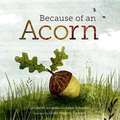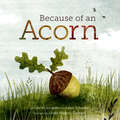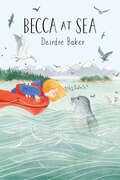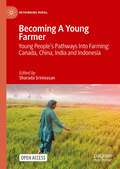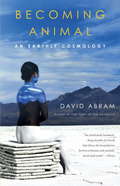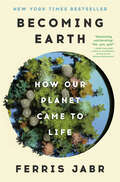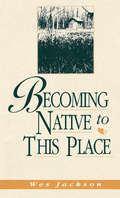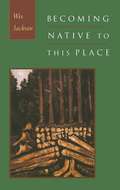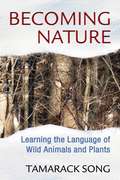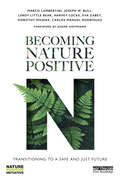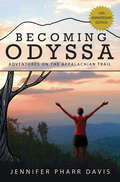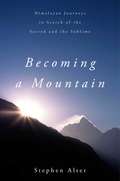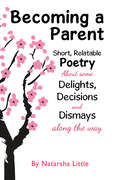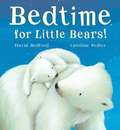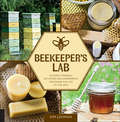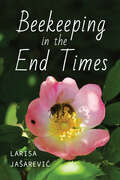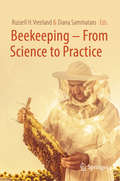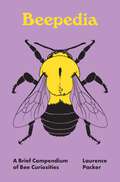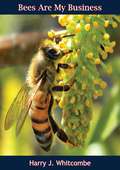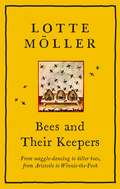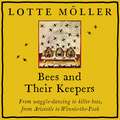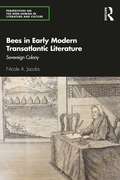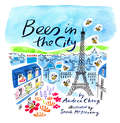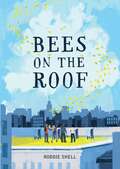- Table View
- List View
Because of an Acorn
by Lola M. Schaefer Adam Schaefer Frann Preston-GannonBecause of an acorn, a tree grows, a bird nests, a seed becomes a flower. Enchanting die-cuts illustrate the vital connections between the layers of an ecosystem in this magical book. Wander down the forest path to learn how every tree, flower, plant, and animal connect to one another in spiraling circles of life. An acorn is just the beginning.
Because of an Acorn
by Lola M. Schaefer Adam SchaeferBecause of an acorn, a tree grows, a bird nests, a seed becomes a flower. Enchanting die-cuts illustrate the vital connections between the layers of an ecosystem in this magical book. Wander down the forest path to learn how every tree, flower, plant, and animal connect to one another in spiraling circles of life. An acorn is just the beginning. Plus, this is the fixed format version, which looks almost identical to the print edition.
Becca at Sea
by Deirdre Baker“One girl’s winter, spring and summer of wonder and growth on a glorious northwest coast island.” — KirkusBecca has often gone with her parents to visit Gran at her rustic cabin by the sea. But this year Becca’s mother is expecting a baby, and Becca visits her grandmother on her own. The prospect of spending time at Gran’s — with her peculiar plumbing and ridiculous Scrabble rules — is hardly appealing.Then, on her very first night, Becca finds an oyster full of pearls. One pearl for every adventure to come?As her mother’s pregnancy progresses, Becca returns to the island again and again. And through a busy parade of visiting relatives — some welcome, some not — she faces the cacophony of the annual herring run in a leaky dinghy, is kissed by a seal, scales a cliff, sails a boat for the first time and goes skinny-dipping in a sea of luminescence. And by the time her parents arrive with the new baby, she realizes that adventures, and even friends to share them with, may have been right under her nose the whole time.Correlates to the Common Core State Standards in English Language Arts:CCSS.ELA-LITERACY.RL.2.6Acknowledge differences in the points of view of characters, including by speaking in a different voice for each character when reading dialogue aloud.CCSS.ELA-LITERACY.RL.4.3>Describe in depth a character, setting, or event in a story or drama, drawing on specific details in the text (e.g., a character's thoughts, words, or actions).CCSS.ELA-LITERACY.RL.5.3Compare and contrast two or more characters, settings, or events in a story or drama, drawing on specific details in the text (e.g., how characters interact).
Becoming A Young Farmer: Young People’s Pathways Into Farming: Canada, China, India and Indonesia (Rethinking Rural)
by Sharada SrinivasanThis open access book is based on a multi-country collaborative research project focussing on Canada, China, India, and Indonesia.It responds directly and concretely to concerns about the generational sustainability of smallholder farming worldwide– reflected in the current UN Decade of Family Farming. Drawing on research that asks how (some) young people continue to pursue a (future) livelihood in farming, the book uses the life-course perspective and privileges voices of young farmers to show that movement away from farming such as time spent in education, migration and non-farm work does not exclude eventual farming futures.The book will be of interest to scholars and students of agrarian studies, anthropology, development studies, gender studies, human geography, rural sociology, and youth studies.
Becoming Animal
by David AbramDavid Abram's first book, The Spell of the Sensuous--hailed as "revolutionary" by the Los Angeles Times, as "daring and truly original" by Science--has become a classic of environmental literature. Now Abram returns with a startling exploration of our human entanglement with the rest of nature. As the climate veers toward catastrophe, the innumerable losses cascading through the biosphere make vividly evident the need for a metamorphosis in our relation to the living land. For too long we've inured ourselves to the wild intelligence of our muscled flesh, taking our primary truths from technologies that hold the living world at a distance. This book subverts that distance, drawing readers ever deeper into their animal senses in order to explore, from within, the elemental kinship between the body and the breathing Earth. The shapeshifting of ravens, the erotic nature of gravity, the eloquence of thunder, the pleasures of being edible: all have their place in Abram's investigation. He shows that from the awakened perspective of the human animal, awareness (or mind) is not an exclusive possession of our species but a lucid quality of the biosphere itself--a quality in which we, along with the oaks and the spiders, steadily participate. With the audacity of its vision and the luminosity of its prose, Becoming Animal sets a new benchmark for the human appraisal of our place in the whole.From the Hardcover edition.
Becoming Earth: How Our Planet Came to Life
by Ferris JabrA vivid account of a major shift in how we understand Earth, from an exceptionally talented new voice. Earth is not simply an inanimate planet on which life evolved, but rather a planet that came to life.&“Glorious . . . full of achingly beautiful passages, mind-bending conceptual twists, and wonderful characters. Jabr reveals how Earth has been profoundly, miraculously shaped by life.&”—Ed Yong, Pulitzer Prize winner and bestselling author of An Immense WorldFINALIST FOR THE LOS ANGELES TIMES BOOK PRIZE • FINALIST FOR THE OREGON BOOK AWARD • AN AMERICAN LIBRARY ASSOCIATION NOTABLE BOOK OF THE YEAR A BEST BOOK OF THE YEAR: Smithsonian, Chicago Public Library, Booklist, Scientific American, NatureA BEST BOOK OF THE SUMMER: The Atlantic and NPR&’s Science FridayOne of humanity&’s oldest beliefs is that our world is alive. Though once ridiculed by some scientists, the idea of Earth as a vast interconnected living system has gained acceptance in recent decades. We, and all living things, are more than inhabitants of Earth—we are Earth, an outgrowth of its structure and an engine of its evolution. Life and its environment have coevolved for billions of years, transforming a lump of orbiting rock into a cosmic oasis—a planet that breathes, metabolizes, and regulates its climate.Acclaimed science writer Ferris Jabr reveals a radical new vision of Earth where lush forests spew water, pollen, and bacteria to summon rain; giant animals engineer the very landscapes they roam; microbes chew rock to shape continents; and microscopic plankton, some as glittering as carved jewels, remake the air and sea.Humans are one of the most extreme examples of life transforming Earth. Through fossil fuel consumption, agriculture, and pollution, we have altered more layers of the planet in less time than any other species, pushing Earth into a crisis. But we are also uniquely able to understand and protect the planet&’s wondrous ecology and self-stabilizing processes. Jabr introduces us to a diverse cast of fascinating people who have devoted themselves to this vital work.Becoming Earth is an exhilarating journey through the hidden workings of our planetary symphony—its players, its instruments, and the music of life that emerges—and an invitation to reexamine our place in it. How well we play our part will determine what kind of Earth our descendants inherit for millennia to come.
Becoming Native to This Place (Blazer Lectures)
by Wes JacksonIn this essay collection, one of the foremost voices in sustainable agriculture sets out a new approach to farming and community engagement.In these six compelling essays, Wes Jackson lays the foundation for a new farming economy grounded in nature's principles and located in dying small towns and rural communities. Exploding the tenets of industrial agriculture, Jackson seeks to integrate food production with nature in a way that sustains both.Jackson’s radical vision is directly at odds with a modern consumer culture that deprives us of any meaningful connection to our natural and social environments. His essays, anchored in his work with The Land Institute, offer an authentic and practical approach to topics that often fail to escape the realm of theory.
Becoming Native to this Place
by Wes JacksonFrom the book: "It has never been our national goal to become native to this place. It has never seemed necessary even to begin such a journey. And now, almost too late, we perceive its necessity. Unfortunately, the nature of the nativeness toward which we must work has been not merely altered but severely compromised. Part of the reason is that we have eight and a half times as many people in our country as we did when my grandfather was born. Perhaps even worse, the forces that have given us our modern problems--the ozone hole and global warming, acid rain, Three Mile Island and Chernobyl, soil erosion and loss of family farms, and so on--gain power by the decade. Destruction is occurring at an accelerating pace. It has all happened so fast (more than 80 percent of all the oil ever burned has been burned in my lifetime) [He was born 1936.] and it is going to get worse--half of Mexico's population is under fifteen years of age, ready for a major explosion. The world is slated to add one billion people in the 1990s alone. More people will be added in ten years than the total population of the earth at the time of Columbus. This book is dedicated to the idea that the majority of solutions to both global and local problems must take place at the level of the expanded tribe, what civilization calls community. In effect, we will be required to become native to our little places if we are to become native to this place, this continent"
Becoming Nature
by Tamarack SongA step-by-step guide to animal communication, connecting with your primal mind, and immersing yourself in Nature - Includes exercises for learning how to become invisible within Nature, sense hidden animals, and communicate with wild animals and birds - Explains how to approach wild animals and form friendships with them - Details the intuitive awareness of our hunter-gatherer ancestors and their innate oneness with Nature Animals and plants are in constant communication with the world around them. To join the conversation, we need only to connect with our primal mind and recognize that we, too, are Nature. Once in this state, we can communicate with animals as effortlessly as talking with friends. The songs of birds and the calls of animals start to make sense. We begin to see the reasons for their actions and discover that we can feel what they feel. We can sense the hidden animals around us, then get close enough to look into their eyes and touch them. Immersed in Nature, we are no longer intruders, but fellow beings moving in symphony with the Dance of Life. In this guide to becoming one with Nature, Tamarack Song provides step-by-step instructions for reawakening the innate sensory and intuitive abilities that our hunter-gatherer ancestors relied upon--abilities imprinted in our DNA yet long forgotten. Through exercises and experiential stories, the author guides us to immerse ourselves in Nature at the deepest levels of perception, which allows us to sense the surrounding world and the living beings in it as extensions of our own awareness. He details how to open our minds and hearts to listen and communicate in the wordless language of wild animals and plants. He explains how to hone our imagining skill so we can transform into the animal we are seeking, along with becoming invisible by entering the silence of Nature. He shows how to approach a wild animal on her own terms, which erases her fear and shyness. Allowing us to feel the blind yearning of a vixen Fox in heat and the terror of a Squirrel fleeing a Pine Marten, the practices in this book strip away everything that separates us from the animals. They enable us to restore our kinship with the natural world, strengthen our spiritual relationships with the animals who share our planet, and discover the true essence of the wild within us.
Becoming Nature Positive: Transitioning to a Safe and Just Future (Routledge Studies in Conservation and the Environment)
by Marco Lambertini Joseph W. Bull Leroy Little Bear Harvey Locke Eva Zabey Dorothy Maseke Carlos Manuel RodríguezAs humanity sits at an existential crossroads, this book introduces the need to build a nature-positive future to secure the functioning and stability of Earth systems essential to the survival and wellbeing of present and future human generations as well as the rest of Earth's amazing diversity of life. Alongside the change in climate, a more silent but equally terrifying crisis is unfolding: the loss of nature and biodiversity. These twin crises are in fact interconnected. After decades of ignoring our impacts on the natural world, we are beginning to realise that nature conservation is a security issue for humanity, and an imperative for intersectional and intergenerational justice. For these reasons, we must embrace a transition from a nature-negative to a nature-positive society, one that ensures human development and addresses today’s inequality, while conserving, restoring and sustainably benefiting from nature's resources and services. A Nature Positive future is one with more nature than today: more forests, more fish, more pollinators, more soil biodiversity, with benefits for the Planet and for us. In this book we define what becoming Nature Positive means from a variety of perspectives, what it takes to deliver it and why it is possible and, most importantly, necessary.This book is essential reading for those concerned with conserving nature and securing a safe future for humanity in the face of climate breakdown, biodiversity loss, and ecological collapse. The future can be bright. The choice is ours.
Becoming Odyssa: Adventures on the Appalachian Trail
by Jennifer Pharr DavisAfter graduating from college, Jennifer isn't sure what she wants to do with her life. Through inexperienced and unprepared, she feels drawn to the Appalachian Trail and sets out along on the long-distance footpath that stretches 2, 175 miles from Georgia to Maine. The next five months are the most physically and emotionally challenging of her life—coping with blisters and aching shoulders, hiking through endless torrents of rain and a blizzard, facing unwanted company and encountering tragedy. The trail becomes a modern day Odyssey that tests Jennifer's faith in God, humanity and herself. But even at her lowest points, it provides enduring friendships, unexpected laughter, and the gift of self-discovery. With every step she takes, Jennifer transitions from an over-confident college graduate to a student of the trail. As she travels along the ridges of the ancient mountain chain, she realizes that she isn't walking through nature—she realizes she is part of nature. And she learns that the Appalachian Trails is more than a 2,175 mile hike: it is a journey that will change a person forever.
Becoming a Mountain: Himalayan Journeys in Search of the Sacred and the Sublime
by Stephen AlterStephen Alter was raised by American missionary parents in the hill station of Mussoorie, in the foothills of the Himalayas, where he and his wife, Ameeta, now live. Their idyllic existence was brutally interrupted when four armed intruders invaded their house and viciously attacked them, leaving them for dead. The violent assault and the trauma of almost dying left him questioning assumptions he had lived by since childhood. For the first time, he encountered the face of evil and the terror of the unknown. He felt like a foreigner in the land of his birth. This book is his account of a series of treks he took in the high Himalayas following his convalescence--to Bandar Punch (the monkey’s tail), Nanda Devi, the second highest mountain in India, and Mt. Kailash in Tibet. He set himself this goal to prove that he had healed mentally as well as physically and to re-knit his connection to his homeland. Undertaken out of sorrow, the treks become a moving soul journey, a way to rediscover mountains in his inner landscape. Weaving together observations of the natural world, Himalayan history, folklore and mythology, as well as encounters with other pilgrims along the way, Stephen Alter has given us a moving meditation on the solace of high places, and on the hidden meanings and enduring mystery of mountains.
Becoming a Parent: Short, Relatable Poetry About the Delights, Decisions and Dismays Along the Way
by Natarsha LittleBecoming a Parent is an exciting and diverse collection of short poems written to be relatable to anyone on this journey.The time of becoming a parent is an exciting one: a time to learn a lot about yourselves and others. You’ll be faced with unforgettable moments and delightful decisions. This book hopes to give you a little insight to some of these moments and decisions. Some poems express joy, others sorrow; but most express the abundance of love you feel for your child.Everyone is different in what they experience or what they may choose to do when becoming a parent, and that’s okay.(The secret messages highlighted in each poem give you a little message as an extra.)
Bedtime for Little Bears!
by David BedfordAfter a long day of exploring in the snow, it's time for Little Bear to go to bed. But he's not tired yet! So Mother Bear and Little Bear go on one last walk to see the other animals getting ready for bed. Will this make Little Bear sleepy enough to snuggle down for the night?
Bee Time: Lessons from the Hive
by Mark L. WinstonBeing among bees is a full-body experience, Mark Winston writes. Bee Time presents his reflections on three decades spent studying these remarkable creatures, and on the lessons they can teach about how humans might better interact with one another and the natural world, from the boardroom to urban design to agricultural ecosystems.
Beekeeper's Lab: 52 Family-Friendly Activities and Experiments Exploring the Life of the Hive
by Kim Lehman"Very informative and fun . . . Science, art, bee care, 52 different labs to entertain, delight, educate and inspire everyone in your family." —A Net in TimeBeekeeping's popularity as a hobby continues to skyrocket. And now, with Beekeeper's Lab, you can fill the year ahead with weekly activities from around and about the hive—including art projects, recipes, experiments, garden activities, and more!Bees are important to local ecosystems,now more than ever. Whether you're already a beekeeper, or are still considering getting your first hive, Beekeeper's Lab has projects perfect for you. This extensive guide book features 52 beekeeping and hive-inspired projects to keep you involved with your buzzing friends all year long.The tutorials are brief, accomplishable, rewarding, and best of all, they are presented in afriendly lab-style format. Try a new technique each weekwith how-tos and sidebars with tips that are perfect for the whole family. Beekeeping is a fun hobby to enjoy, plus, who doesn't want their own supply of honey?
Beekeeping in the End Times
by Larisa JašarevićEvery hundred years, as the story goes, two angels wonder out loud whether the bees are still swarming. For as long as the bees are swarming, the angels are reassured, the world holds together. Still, the tale suggests, the angels live in anxious anticipation of the End. Local beekeepers in Bosnia and Herzegovina retell the old tale with growing unease, as their honeybees weather the ground effects of climate change.Beekeeping in the End Times relates extreme weather events and quieter disasters that have been altering honey ecologies across Bosnia and Herzegovina since 2014. While world-wide endangerment of pollinators, and bees in particular, has been the subject of much global concern, effects of climate change on the indispensable honeybees,remain understudied. Drawing on a five-year long study, the book suggests that local apiarists' field observations resonate with many climate biologists' concerns and speculations about the future of plant-bee relations on the warming planet. Local practice also adds to the record complex and puzzling trends that make honey scarce in otherwise lush, biodiverse landscapes.To Bosnian Muslims, honeybees are more than pollinators. They are inspired beings whose honey is another form of divinely revelation. To appreciate the meaning of honeybees and to grasp the dire ecological catastrophe underway, Jašarević reads contemporary environmental writings and Sufi texts, she listens to the seasoned beekeepers and collects local wisdom tales. From start to finish, Jašarević pores over key Islamic texts, the Quran and the Hadith, and their popular retellings. The Islamic end-times lore, the book proposes, holds surprising lessons on how to live and strive in the 'not yet,' stalling the apocalypse.
Beekeeping – From Science to Practice
by Diana Sammataro Russell H. VreelandThis book will help beekeepers understand the fundamentals of beekeeping science. Written in plain and accessible language by actual researchers, it should be part of every beekeeper's library. The respective chapters not only present raw data; they also explain how to read and understand the most common figures. With topics ranging from honeybee nutrition to strains of Varroa resistant bees, from the effects of pesticide chemicals to understanding diseases, and including a discussion of venom allergies, the book provides essential "knowhow" that beekeepers will benefit from every time they inspect their hives. Further, each chapter ends with the author explaining how beekeepers can (or cannot) directly utilize the information to enhance their beekeeping operation. The text is structured to facilitate ease of use, with each author addressing the same four issues: 1) What are the specific purposes or goals of these experiments? Or more simply: what have these studies taught us? 2) How should a non-scientist read the data generated? 3) What are the key points in relation to practicing beekeepers' goals? 4) How can the data or techniques discussed be applied by beekeepers in their own apiaries? This approach allows readers to look up specific information quickly, understand it and even put it to use without having to read entire chapters. Further, the chapters are highly readable and concise. As such, the book offers a valuable guide and faithful companion for all beekeepers, one they can use day in and day out.
Beepedia: A Brief Compendium of Bee Curiosities (Pedia Books)
by Laurence PackerAn enchanting, fact-filled treasury for the bee lover in all of usBeepedia is a one-of-a-kind celebration of bees, from A to Z. Featuring dozens of alphabetical entries on topics ranging from pollination and beekeeping to the peculiar lifestyles of cuckoo bees and carrion-eating vulture bees, this enticing, pocket-sized compendium takes you on an unforgettable journey into the remarkable world of bees.Explore the many wonders of bee morphology, behavior, and ecology, and learn about the role of bees in agriculture, art, literature, and religion. With more than 20,000 described species, bees can be found anywhere on the planet where flowering plants are pollinated by insects. With Laurence Packer as your guide, you will meet some of the most inquisitive and prolific bee experts who ever lived and marvel at the astonishing variety of wild bees and the creative methods scientists use to study them. Discover why bees have intrigued us for millennia, why Napoleon Bonaparte chose the bee as his emblem when he became emperor, where the expression &“the bee&’s knees&” comes from, and much more.With captivating drawings by Ann Sanderson, Beepedia is an informative and entertaining blend of fact, folklore, and fancy that will captivate anyone who has ever been curious about these amazing insects.Features a cloth cover with an elaborate foil-stamped design
Bees Are My Business
by Harry J. Whitcombe John Scott DouglasWhen Harry Whitcombe was seven years old he persuaded a not very enthusiastic father to let him have a hive of bees. From that day on, bees were his business. It was often a precarious business, but it was to prove its worth more than once during the depression, when Whitcombe, still in high school, helped balance the family budget by selling five-gallon cans of honey to a local grocer. Later the sale of his apiary, grown to a hundred colonies, helped pay his way through college.As time went on, Harry Whitcombe found that his real interest lay in the part beekeeping could be made to play in replenishing the soil through pollination of crops. There were many lean years, but Harry Whitcombe persisted, and he became one of the largest shippers of package bees in the world. He was the first man ever to ship bees by plane and his bees were flown all over the United States and Canada and to Europe, India, Korea, Guam and Israel.This heartwarming human success story is told against a background rich in information of vast importance to all of us and of practical value to beekeepers. With amazing clarity the authors describe the science of beekeeping from elementary facts about hives and swarms, to the science of pollination. It is the only book of its kind that relates the story of the beekeeping industry to agriculture. It tells the story of modern commercial beekeeping and vividly describes how bee pollination contributes to man’s dinner table in meat, milk, butter, vegetables and fruits. It explains how the application of insecticides, such as DDT, kills both beneficial as well as injurious insects and how the honey bee has taken over pollination for continued production of many crops.
Bees and Their Keepers: From waggle-dancing to killer bees, from Aristotle to Winnie-the-Pooh
by Lotte MöllerA beautifully illustrated and thoroughly engaging cultural history of beekeeping - packed with anecdote, humour and enriching historical detail. The perfect gift."A charming look at the history of beekeeping, from myth and folklore to our practical relationship with bees" Gardens Illustrated"An entertaining collation of bee trivia across the millennia" Daily Telegraph* Sweden's Gardening Book of the Year 2019 * Shortlisted for the August Prize 2019 * Winner of the Swedish Book Design Award for 2019Beekeeper and garden historian Lotte Möller explores the activities inside and outside the hive while charting the bees' natural order and habits. With a light touch she uses her encyclopaedic knowledge of the subject to shed light on humanity's understanding of bees and bee lore from antiquity to the present. A humorous debunking of the myths that have held for centuries is matched by a wry exploration of how and when they were replaced by fact. In her travels Möller encounters a trigger-happy Californian beekeeper raging against both killer bees and bee politics, warring beekeepers on the Danish island of Læso, and Brother Adam of Buckfast Abbey, breeder of the Buckfast queen now popular throughout Europe and beyond, as well a host of others as passionate as she about the complex world of apiculture both past and present.Translated from the Swedish by Frank Perry
Bees and Their Keepers: From waggle-dancing to killer bees, from Aristotle to Winnie-the-Pooh
by Lotte MöllerWith deep knowledge and a sharp wit, Lotte Möller unfolds our understanding of bees and bee lore from antiquity to the present. A beekeeper herself, she gives insight into the activity in the hive and describes the bees' natural order and habits. She explores the myths of the past, and how and when they were replaced by fact. For example, the heated discussions that broke out in the eighteenth century when it was discovered that the hive was ruled by a queen, not a king as had been the belief since Aristotle. In her travels Möller encounters a host of colourful characters, from a trigger-happy Californian beekeeper raging against both killer bees and bee politics, to the warring beekeepers on the island of Læso and Brother Adam of Buckfast Abbey, breeder of the Buckfast queen now popular throughout Europe and beyond. Bees and Their Keepers is a compelling cultural history for the beekeeper and general reader alike.Translated from the Swedish by Frank Perry(P)2020 Quercus Editions Limited
Bees in Early Modern Transatlantic Literature: Sovereign Colony (Perspectives on the Non-Human in Literature and Culture)
by Nicole A. JacobsThis book examines apian imagery—bees, drones, honey, and the hive—in the seventeenth- and eighteenth-century literary and oral traditions. In England and the New World colonies during a critical period of expansion, the metaphor of this communal society faced unprecedented challenges even as it came to emblematize the process of colonization itself. The beehive connected the labor of those marginalized by race, class, gender, or species to larger considerations of sovereignty. This study examines the works of William Shakespeare; Francis Daniel Pastorius; Hopi, Wyandotte, and Pocasset cultures; John Milton; Hester Pulter; and Bernard Mandeville. Its contribution lies in its exploration of the simultaneously recuperative and destructive narratives that place the bee at the nexus of the human, the animal, and the environment. The book argues that bees play a central representational and physical role in shaping conflicts over hierarchies of the early transatlantic world.
Bees in the City
by Andrea Cheng Sarah McMenemy2018 Green Earth Book Award Finalist Lionel lives in a Paris apartment building but loves keeping bees with his Aunt Celine at her farm outside the city. But when her bees start dying, how can he help? The solution, he realizes, is in the rooftop gardens and window boxes of his apartment neighbors, representing a varied and continuously blooming array of flowers that the bees will love. Aunt Celine must bring her bees to Paris! But first he and his friends Alice and Samir must convince their skeptical neighbors and landlord, Mr. Dubi, that this is a good idea. Adorned with Parisian skylines, Bees in the City is a love letter to the City of Light and a celebration of the can-do spirit of kids. Sarah McMenemy’s illustrations recall the Parisian magic of Madeleine. The book’s backmatter explores urban beekeeping and rooftop gardening in greater depth. Fountas & Pinnell Level P
Bees on the Roof
by Robbie ShellSam needs to find a seventh-grade science fair project and a way to save the restaurant where his father works. When he enrolls three friends in an effort to raise bees on a hotel roof in New York City, the complications multiply. Bee sting allergies, a great bee die-off, a rival team's cheating, a mysteriously reclusive science teacher, and Sam's romantic feelings for a classmate make the bee project anything but simple. This story includes lots of facts about bees and Colony Collapse Disorder.
